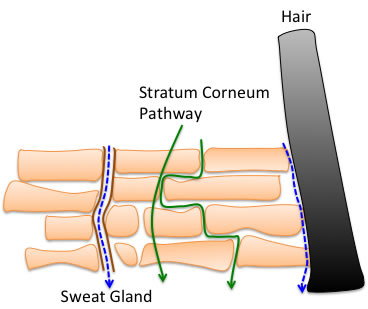If it is an artificial homogeneous polymer, the solubility parameter of the polymer is determined by one.
Chemical compounds with HSPs similar to the polymer’s HSP would dissolve the polymer well, rather than penetrate it well.
So what about the skin, which is not homogeneous by any stretch of the imagination?
This means that there is no single HSP for skin.
So how many different pathways are there in the skin?
Is there a way to find out?
This is because when trying to create a QSAR equation to predict the transmission coefficient Kp through the skin, I want to calculate the HSP distance to the pathway that is closest to the HSP of the compound.
The model equation is created based on that shortest HSP distance and the size, shape and kinetic state of the molecule.

In such cases, a SOM (Self Organisation Map) is created using the HSPs (dD, dP, dHAcid, dHbase) of the compounds with known transmission coefficients.
Simply put, the SOM method is a technique for ‘mapping similar vectors to similar locations on two dimensions’.
So, if I map the HSPs in 4 dimensions, the ones with similar HSPs will be mapped close together. So I circled in red where the ones with high transmission coefficient Kp (labelled as 1) are located.
To eliminate boundaries, this SOM was calculated and cut open by attaching the top and bottom edges of a square to make a cylinder, and then attaching the left and right sides of the cylinder to make a donut.
Of course, the transmission coefficient may be labelled as 2 or 3 if the molecule is large, even if the HSPs are well matched.
However, broadly speaking, it can be seen that there are likely to be about six different HSP pathways in the skin.
In other words, one wants to consider the transmission coefficient Kp of a compound. Once the structure is known, the HSP can be calculated using Y-MB. Then you can calculate the distance between the HSP and the HSP of these six red circles.
The compound is considered to penetrate the Pathway with the shortest HSP distance.
I am a little concerned because the model using HSP does not seem to assume multiple pathways at a cursory glance. (Conversely, this means that I can patent and publish as many papers as I want, which is a good thing.)
This is also the story of a study group with students at the PIRIKA study group.

